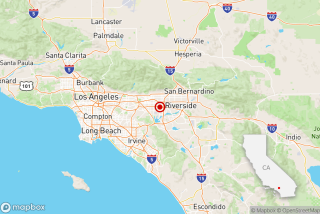5.4 Quake Hits Near Big Bear, Is Felt Throughout Southland
- Share via
A magnitude 5.4 earthquake struck just north of Big Bear Lake in the San Bernardino Mountains before dawn Saturday, and although there was little damage and no injuries, the temblor’s 14 aftershocks kept the mountain resort area jittery throughout the morning.
The main jolt was at 4:19 a.m., and the strongest aftershocks registered magnitudes from 4.0 to 4.5.
Caltech seismologist Egill Hauksson placed the epicenter near the Helendale fault, two miles north of Big Bear City, at a depth of about four miles. He said it was not an aftershock of the powerful Landers-Big Bear quakes of June 28, 1992.
The main quake Saturday was felt as far off as Los Angeles, San Diego and Palmdale, and was the strongest temblor to hit Southern California since a similar 5.4 quake northeast of Barstow on March 18, 1997. The quake was five times more powerful than the 4.8 shaker centered near Yorba Linda in Orange County on Sept. 3.
Scattered breakage of windows and damaged goods were reported around Big Bear, which is about 100 miles from Los Angeles.
At the Holiday Inn in Big Bear Lake, a large lamp attached to a heavy cable smashed into a wrought-iron table and broke into pieces from the shaking, and at least six bottles broke in the hotel bar, said General Manager Ken Sliwa.
A slight crack appeared in an interior wall, he said.
“I was kind of half asleep when it occurred, but there was a fairly strong aftershock a minute later, and then several others,” Sliwa said. “I found many, many of our guests outside their rooms, and did my best to calm everybody down.”
Diane Hermans, a Big Bear City resident, said some knickknacks fell off her fireplace mantel.
“Basically, it was a kind of a fast, violent shaking, and wasn’t one that shook for a long, long time, but it shook pretty good,” she said.
At Thelma’s Restaurant, head waitress Shawn Early said, “We had a little damage, not too bad. The back wall came out of the wood storage shed, and all the firewood’s all over the parking lot.”
The quake “was pretty good,” said Ricky Jett, who has lived in Big Bear for the last decade.
But, he added, “Actually, people up here don’t really seem to worry about earthquakes too much. I have the basics [set aside] -- water, canned food and some blankets” in case of a destructive one.
Hauksson, the Caltech seismologist, said Saturday’s quakes were close to the epicenter of a 5.4 aftershock of the Landers-Big Bear quakes that took place near the Helendale fault on Nov. 27, 1997. That one also caused little damage.
But he said the latest quake, occurring on a horizontal fault plane dipping into the Earth at about an 80-degree angle, was new seismic activity in a vicinity that over recent years has had quite a bit of it.
“The 1992 magnitude 7.3 Landers quake and the 1999 magnitude 7.1 Hector Mine earthquake occurred in the Eastern California Shear Zone that cuts across the Mojave Desert, forming a 40-mile-wide swath of crustal deformation,” Hauksson said.
“The Landers earthquake was located toward the middle of the zone, while the Hector Mine occurred near the eastern edge of the zone. In contrast, the Helendale fault forms the western edge of the zone. It has contributed to the generation of past clusters of large earthquakes in the zone.”
Stanford University earthquake scientists have theorized in recent years that Southern California’s great tectonic plate boundary between the Pacific and North American plates may, over many thousands of years, be shifting away from the San Andreas fault to the shear zone, and the new plate boundary may ultimately run up out of the Mojave Desert to the eastern side of the Sierra Nevada.
*
Freelance writer Deborah Sullivan Brennan in Big Bear contributed to this report.
More to Read
Sign up for Essential California
The most important California stories and recommendations in your inbox every morning.
You may occasionally receive promotional content from the Los Angeles Times.










